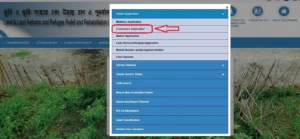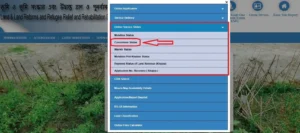Banglarbhumi Conversion Application & Status — Complete Guide (2025)
The Government of West Bengal provides several digital land services through its official portal Banglarbhumi. Among these, the Conversion Application is a crucial service that allows landowners to legally change the classification of their land—for example, converting agricultural land into residential, commercial, or industrial land.
Equally important is the ability to track the Conversion Application Status online, ensuring that applicants remain updated on the progress of their request.
In this article, we will provide a comprehensive, step-by-step guide covering eligibility, required documents, fees, application process, and how to track your status in real-time.
What Is Banglarbhumi Conversion? (Definition, Scope & Legal Basis)
“Land conversion” under the West Bengal Land Reforms Act, 1955 (WBLR Act) refers to changing the land use classification from one category to another.
- Examples of conversion:
- Agricultural land → Residential (Bastu)
- Agricultural land → Commercial (shops, hotels, etc.)
- Agricultural land → Industrial (factories, warehouses)
- Patit/Danga land → Bastu
- In some cases, even water-body conversion (subject to restrictions).
- Legal Basis:
The process is regulated under Sections 4A, 4B, 4C, and 4D of the WBLR Act, 1955, along with Rule 5A of the WBLR Rules. These sections ensure that conversion is carried out with due approval from revenue authorities.
Banglarbhumi Conversion Application & Status — Key Things to Know Before You Apply
Before submitting a Conversion Application, you must check:
- Eligibility: Only the recorded owner of the land (whose name appears in the Record of Rights / Khatian) can apply.
- Restrictions: Certain categories (e.g., vested land, government land, forest land, water bodies) may not be eligible for conversion.
- Approval Authority:
- BLLRO (Block Land & Land Reforms Officer): Small land areas.
- SDLLRO (Sub-Divisional Land & Land Reforms Officer): Medium land areas.
- DLLRO (District Land & Land Reforms Officer): Large-scale land conversion.
Applicants should also be aware of the fees involved—which include application fees, processing charges, and conversion fees depending on land type and location.

Step-by-Step — Banglarbhumi Conversion Application (Online)
Follow these steps to apply for land conversion through the Banglarbhumi portal:
1. Login to the Portal
- Visit Banglarbhumi.gov.in.
- Go to Citizen Services → Online Application → Conversion Application.
2. Fill Out Conversion Application Form
You will need to enter:
- District, Block, Mouza details.
- Khatian number and Plot number.
- Existing land classification.
- Proposed classification (Bastu/Industrial/Commercial).
- Purpose of conversion.
3. Upload Required Documents
Scanned copies of mandatory documents must be uploaded (details below).
4. Pay the Fees
- Online payment (Net Banking/Debit Card) or
- Treasury challan (if required in specific districts).
5. Note the Application Identification Number (AIN)
- After submission, you’ll receive an Application Identification Number (AIN).
- This number is vital for tracking your Banglarbhumi Conversion Status.
Banglarbhumi Conversion Application Status — How to Track in Real Time

Tracking the status ensures transparency and reduces delays.
- Step 1: Go to Banglarbhumi → Citizen Services → Online Application → Inspection Report.
- Step 2: Enter your Application Identification Number (AIN).
- Step 3: Click Search to view current status.
Common Status Updates You May See:
- Submitted & Under Scrutiny.
- Documents Verified.
- Site Inspection Scheduled.
- Under Approval (BLLRO/SDLLRO/DLLRO).
- Approved & Order Issued.
- Rejected (with reasons).
Documents Checklist for Banglarbhumi Conversion Application
Before applying, ensure you have:
- Record of Rights (RoR / Khatian copy).
- Latest Khajna (land revenue) receipt.
- Registered Deed / Ownership proof.
- Site map or plan.
- Affidavit stating purpose of conversion.
- ID proof and Address proof.
- NOC (if required for specific land types).
Banglarbhumi Conversion Fees (Application, Processing & Conversion Fee Tables)
Application & Processing Fee
- Standard fee for application processing.
- Post-facto conversion (if you use land for non-agricultural purposes before applying legally) attracts higher charges.
Conversion Fee (Examples per Decimal)
- Rural areas: Lower fee per decimal.
- KMDA (Kolkata Metropolitan Development Area): Higher fee due to urban classification.
- Rates differ for Bastu, Commercial, Industrial, or Water-body conversion.
Example Table:
| Land Type | Rural Fee (₹/decimal) | KMDA Fee (₹/decimal) |
|---|---|---|
| Agricultural → Bastu | 900 | 1200 |
| Agricultural → Commercial | 2000 | 3000 |
| Water-body → Bastu | 2500 | 3500 |
(Values are indicative; applicants must check latest govt. circulars.)
Timeline, Department Workflow & Authorities
- BLLRO handles small applications.
- SDLLRO handles medium plots.
- DLLRO handles large-scale conversions.
- Site inspection is mandatory.
- Approval typically takes 30–90 days depending on workload and documentation.
Post-Approval: Download Banglarbhumi Conversion Order/Certificate
Once approved:
- Login to Banglarbhumi.
- Go to Citizen Services → Inspection Report.
- Download your Conversion Order/Certificate.
- Update your mutation records and tax classification accordingly.
Banglarbhumi Conversion Application & Status — Common Mistakes to Avoid
- Entering incorrect Khatian/Plot numbers.
- Uploading blurred or incomplete documents.
- Not paying correct fees.
- Ignoring notices/queries from BLLRO office.
- Applying for ineligible land categories.
Troubleshooting Banglarbhumi Conversion Application & Status Issues
If you face delays or errors:
- Check if your AIN is correct.
- Verify payment has been processed.
- Contact the local BLLRO/SDLLRO/DLLRO office.
- Visit a CSC (Common Service Centre) for assistance.
Banglarbhumi Conversion vs Mutation vs RS-LR Mapping
- Conversion: Change of land use classification.
- Mutation: Transfer of ownership in records after sale/gift/inheritance.
- RS-LR Mapping: Linking old (RS/Sabek) survey records with new (LR/Hal) records.
FAQs — Banglarbhumi Conversion Application & Status
Q1. How do I check Banglarbhumi Conversion Status?
Use Inspection Report with your AIN.
Q2. What are the current conversion fees?
Fees vary based on land type and whether it’s rural or KMDA.
Q3. Which office approves conversion?
BLLRO, SDLLRO, or DLLRO depending on plot size.
Q4. What documents are mandatory?
RoR/Khatian, Khajna receipt, deed, site map, affidavit, ID proof.
Q5. How long does conversion take?
Generally 1–3 months depending on inspection and authority.
Q6. Can agricultural land be converted to residential?
Yes, subject to approval and payment of conversion fees.
Q7. What is post-facto conversion?
When land use changes before applying legally; fees are higher.
Final Checklist — Success Tips
- Verify your ownership and land records before applying.
- Pay all pending Khajna dues.
- Scan and upload documents clearly.
- Keep your AIN safe for status tracking.
- Regularly check Inspection Report for updates.
- Respond quickly to any objection notices.
Conclusion
The Banglarbhumi Conversion Application & Status service has made it easier for landowners to apply for and monitor the legal process of land use conversion in West Bengal. By carefully preparing documents, paying required fees, and tracking application status online, applicants can ensure a smooth and hassle-free experience.
For accuracy, always refer to:
- Banglarbhumi Official Portal
- WBLR Act, 1955 for legal provisions.
- Government circulars for updated fee charts.
